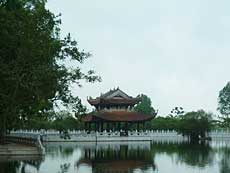It was a beautiful summer morning as we departed under the glistening sunlight to Do Temple in Bac Ninh Province from Hanoi to flee the summer heat and enjoy the fresh air of the temple in the early morning.
 Located in Dinh Bang Village in Tu Son District of Bac Ninh Province, 20 kilometers from Hanoi, Do Temple or Ly Bat De (Eight Kings of Ly Dynasty) Temple honors the eight kings of the Ly Dynasty (1009-1225). The temple has an important role in the spiritual life of Vietnamese people with its richness in the nation's culture.
Located in Dinh Bang Village in Tu Son District of Bac Ninh Province, 20 kilometers from Hanoi, Do Temple or Ly Bat De (Eight Kings of Ly Dynasty) Temple honors the eight kings of the Ly Dynasty (1009-1225). The temple has an important role in the spiritual life of Vietnamese people with its richness in the nation's culture.
It is a popular destination for tourists to Bac Ninh as well as a venue for traditional festivals.
Leaving Hanoi on National Highway 1A, we followed a sign which read 'Do Temple 800 meters' and beckoned us to run along the green-shade lined road studded with red-tiled roofs. And then we reached Do Temple standing imposingly and sacredly with a curved tile roof printed with the color of time.
Living in the bustling and cramped city of Hanoi, we all shouted with glee in the spacious atmosphere of the path to the main gate of the temple striking with ancient tree lines and rumbles of cicadas. On the right is a lake where there is a floating temple and cool and fresh water steam keeping the summer heat at bay.
Do Temple was built in 1019 by the first king of the Ly Dynasty, Ly Cong Uan or Ly Thai To and was enlarged by his son Ly Thai Tong in 1030. The temple was used by Ly Thai To to meet people to ask their opinions on plans to safeguard the country.
It was built on an elevated area of land of 31,250 square meters and is surrounded by high walls. It has more than 20 architectural works and is divided into two parts: inner city and outer city.
Access to the inner city is through the Ngu Long (five dragons) gate, which is skillfully carved, and then to Tien Te House, the shrine to worship the first king.
Hanging on the left side of the shrine is the royal proclamation of the relocation of the capital city from Hoa Lu to Thang Long (Hanoi) of King Ly Cong Uan. The proclamation has 214 words corresponding to 214 years of rule by the eight Ly kings. The 180 square-meter Co Phap Dien shrine is the site of many relics including ancestral altars, the thrones and the statues of the eight kings and a shrine to worship the kings' wives, among others.
In the outer city is a half-moon shaped lake with a floating pavilion and Van chi and Vo chi houses. The lake and the floating pavilion, on an area of 9,500 square meters, served as a place for the mandarins to watch water puppetry. An image of this architectural construction was printed on the banknotes of the Bank of Indochina. Van chi and Vo chi houses were places to worship the civil mandarins (van chi) and military mandarins (vo chi) who were greatly respected around the country.